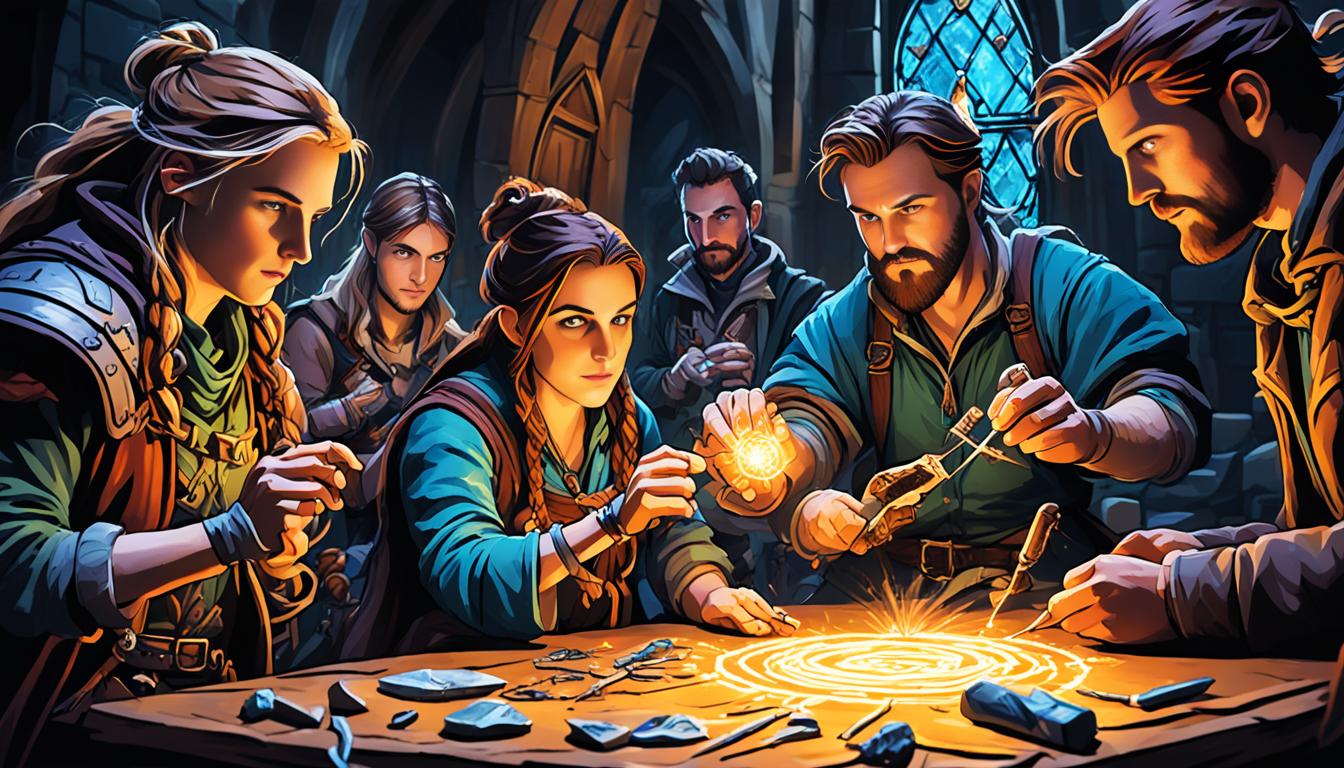Mending 5e Guide: Fixes & Magical Restorations
Mending is a cantrip in Dungeons & Dragons 5th edition that lets you mend items. You can repair a single break or tear on an object up to 1 foot in size. This spell is great for fixing everyday items, like broken chains or torn cloaks. However, it can’t bring back the magic in magical items or constructs.
When you use Mending, there’s no sign that the item was once damaged. It’s a level 0 spell, so you can use it as much as you like without spending spell slots. Casting it takes 1 minute and you must do a few gestures, say some words, and have two lodestones with you.

Key Takeaways:
- Mending is a cantrip in D&D 5e that lets you fix small items.
- It can repair everyday items but not magical ones.
- The item looks like new after you’re done fixing it.
- This is a level 0 spell, so no need to worry about spell slots.
- To cast Mending, say some words, do gestures, and have two lodestones.
Creative Uses of Mending in D&D 5e
In Dungeons & Dragons 5e, mending opens creative doors. It can fix broken items, saving gold on replacements. But its use is wider than just repairs.
Imagine being at an important meeting and your clothes rip. Mending fixes the tear with a touch and whisper. This keeps your image perfect.
It’s also great for saving old books. Torn pages can be fixed to keep adventures going. It brings back ancient artifacts and their stories.
Mending helps in stealth missions too. It fixes locks and objects quietly, aiding your quests. Also, you can break and mend big items for easy transport.
The spell is full of surprises. With imagination, it can be used in many smart ways. And it affects more than just the individual player.
In a world with mending, less gets thrown away. This could start a new way of living, where fixing is better than buying new. It changes jobs and how we think about resources.
Next, it could change how we buy things. In a future of endless mending, buying new could be rare. This could reshape industries and jobs, pushing them to innovate.
So, the mending spell isn’t just for fixing stuff in D&D. It brings game worlds to life with new possibilities. Remember its broad effects and let the fun, creative side of it shine.

The Impact of Mending in Society
Fixing things with mending goes beyond just repairs. It can change how people see and use objects. This means less waste and more value on keeping things longer.
It can also shake up how we do business. Rather than buying new all the time, a repair-focused system could appear. This affects jobs and economies.
Overall, mending in D&D 5e is a game-changer. It’s not just for fixing, but for adding layers to stories and worlds. Consider its many uses and effects next time you play.
Balancing Mending in D&D 5e
Mending adds new options in D&D 5e, however, Dungeon Masters (DMs) must ensure the game stays fair. They need to make sure that the mending spell helps the gameplay without being too powerful against other game features.
To keep things balanced, create situations where mending helps solve problems. This makes players think outside the box. For instance, a mended bridge lets the group move on with their journey.
DMs can make use of puzzles that need players to carefully use mending. This makes them rethink how they can best apply the spell.
But, it’s vital to know that the mending spell has its limits. It can fix objects but not their magic or constructs. By placing clues on objects too big to fully mend, it forces players to use different skills to find hidden information.
Mending takes 1 minute to cast and needs certain gestures and material to work. Repairing heavily damaged items might need several casts. This can slow down the game and risky, possibly leading to unexpected events.
Even with magic, mending can only repair physical damage. Restoring magic requires special rituals or materials. This makes the process of fixing magical items more complex, preserving their value and lore.
Many adventures highlight mending’s useful applications. It can fix important places, cover tracks, or recover ancient objects. These scenarios can inspire DMs to use mending creatively in their games.
DMs must balance mending use to make it a fun problem-solver, not a game-breaker. By recognizing its limits and integrating it well, mending can improve the gaming experience while staying fair and fun.

Enhancing Mending in Higher Levels of D&D 5e
In D&D 5e at higher levels, you can boost the mending spell in cool ways. There are advanced ways to mix it with other spells. This maximizes how well mending works:
Mending Spell Combinations
Join mending with Fabricate for quick fixes by changing raw materials into products. Adventurers can quickly mend or make items. It’s great for crafting and building stuff faster.
Telepathic bond or similar magic lets you fix things from a distance with help from others. It’s useful when it’s hard to touch the object directly.
Mending Spell Multiclassing
Multiclassing lets you grab mending from various classes using spells or feats like Magic Initiate. It boosts your repair spell options. Combine mending with spells like druidcraft to work more efficiently.
Feats and Advanced Uses of Mending Spell
Feats can make mending better. For example, with the Ritual Caster feat, you don’t need lodestones to fix things. This means you can repair stuff whenever, without carrying components.
Picking magic items like a Spellwrought Tattoo can let you mend things often. It’s great for those who use the spell a lot.
The table below gives a quick look at how mending improves in higher D&D 5e levels:
| Enhancement | Description |
|---|---|
| Mending and Fabricate Combination | Use mending with the Fabricate spell to mend and make things quickly. |
| Mending Through Telepathic Bond | Fix things at a distance by using telepathic bond or similar magic. |
| Multiclassing with Mending | Grab mending from different classes through multiclassing for more spell options. |
| Feats and Advanced Uses | Ritual Caster lets you mend without components. Spellwrought Tattoo offers endless mending spells. |

These cool ways to mix and enhance mending add a lot of flexibility and ease. By using these methods, players can really unlock mending’s full power. It becomes a key tool for fixing and upkeeping things in their D&D 5e journeys.
The Impact of Mending on Societies and Economies in D&D 5e
The mending spell in Dungeons & Dragons 5th edition can change how societies and economies work. Imagine a world where everything can be fixed by this spell. This creates a shift to a “rental” economy, where nothing is thrown away. Objects are continually renewed instead.
While this is good for the environment and use of materials, it affects some jobs. People who used to repair things for a living may find less work. Objects might start being made in ways that make them easy to fix, rather than strong but not easy to mend.
But if not everyone can use this spell, certain items could become rare. People with the skill to repair complex objects might be very important. This could lead to an economic system where the ability to mend is highly valued, something that can reflect status.
This magical mending offers a great chance for game creators to think deeply. They can develop worlds where magic affects everything from how things are made to how societies run. Mending magic can make their game settings rich and engaging with deeper stories.
Impact of Mending on Societies and Economies
|Positive Implications| Negative Implications| |A “rental” economy based on continuous renewal of items |Diminishing professions focused on repairing mundane objects| |Reduced waste and increased sustainability| Perpetual scarcity of resources if access to mending is restricted| |Design favoring intricate and easily repaired objects| Complex goods becoming rarer due to limited repair capabilities|
The mending spell in D&D 5e creates a unique story universe. It gives players and game leaders interesting challenges and chances. This spell affects how society, the economy, and the environment interact. It makes the game world rich and complex.
Incorporating Mending into D&D 5e Adventures
The mending spell has become popular in official Dungeons & Dragons 5e adventures. It inspires DMs to use it in their own stories. The spell’s flexibility allows for unique challenges in the game.
In Out of the Abyss, mending helps fix crucial places. It aids the party as they explore the dangerous Underdark. This shows how important the spell can be in tough spots.
Curse of Strahd uses mending for stealth. It helps hide signs of the players’ actions, letting them move through danger easier. Using the spell for secrets and sneakiness makes the game more interesting.
Homebrewers have made their own versions of mending. They can fix bigger areas or even combine items. These new options make the spell even more useful. Adventurers love finding these clever ways to solve problems.
Some groups have created rules that use mending to gather lost arrows and such. This change makes items last longer, which is good for the game’s economy. Players don’t have to buy new gear as often.
Many official adventures include missions that involve the mending spell. They give DMs story ideas where mending is key. This lets players use the spell in fun and important ways. It shows how versatile and important the spell can be.
But, DMs should use mending wisely. Depending on it too much might make the game less fun. It’s best to mix it with other challenges. This keeps the game exciting without making mending too powerful. Using mending in D&D 5e makes adventures more interesting. It encourages players to think outside the box. By adding this spell into the story, DMs can create unforgettable moments where cleverness is key.
Conclusion
Mending is a powerful cantrip in D&D 5e with many uses. It can change how you play the game and make your adventures richer. This is true for both players and Dungeon Masters alike.
Using mending in creative ways can offer players new chances to solve problems. But, it’s important to keep the game challenging too. This makes sure mending is useful without being a quick solution for everything.
Mending can also impact the game’s world around your characters. How common or rare mending is might affect a society’s way of life. It could even change their economy or the look of the things they use. For those creating game worlds, mending is a chance to make an environment feel more real.
As adventurers gain more abilities, mending can become even more useful. Mixing it with other magical skills or items makes it stronger. This can help fix huge buildings, send messages over long distances, or even be part of mixing character classes. Mending’s versatility truly has endless potential.